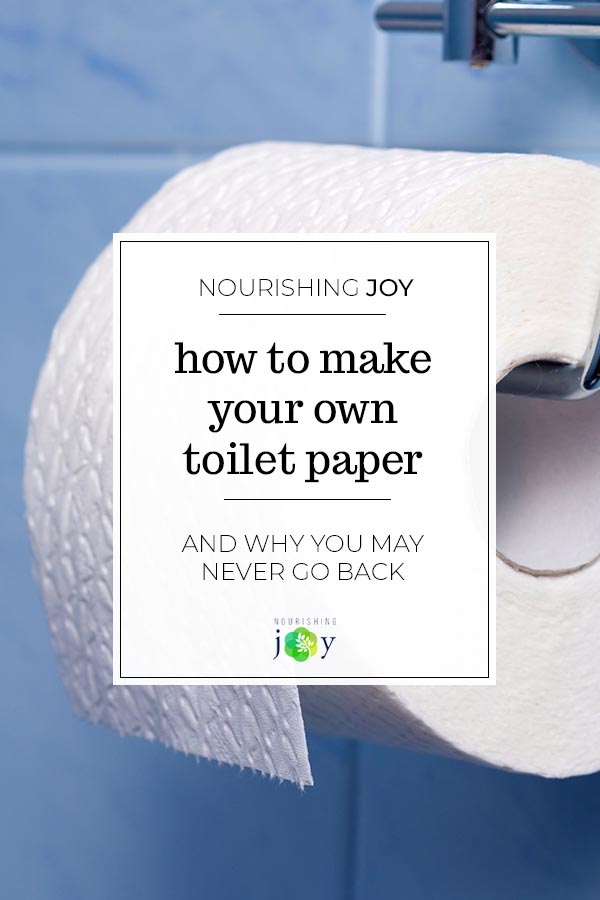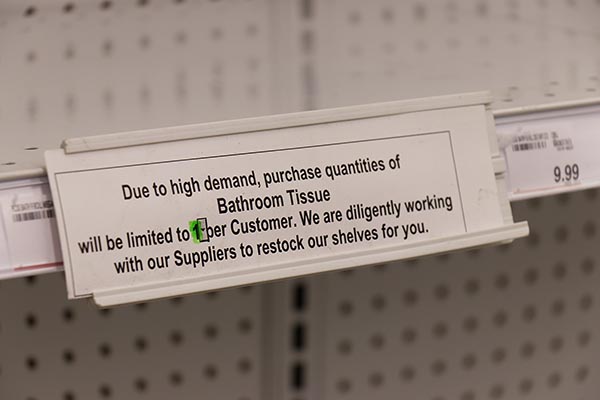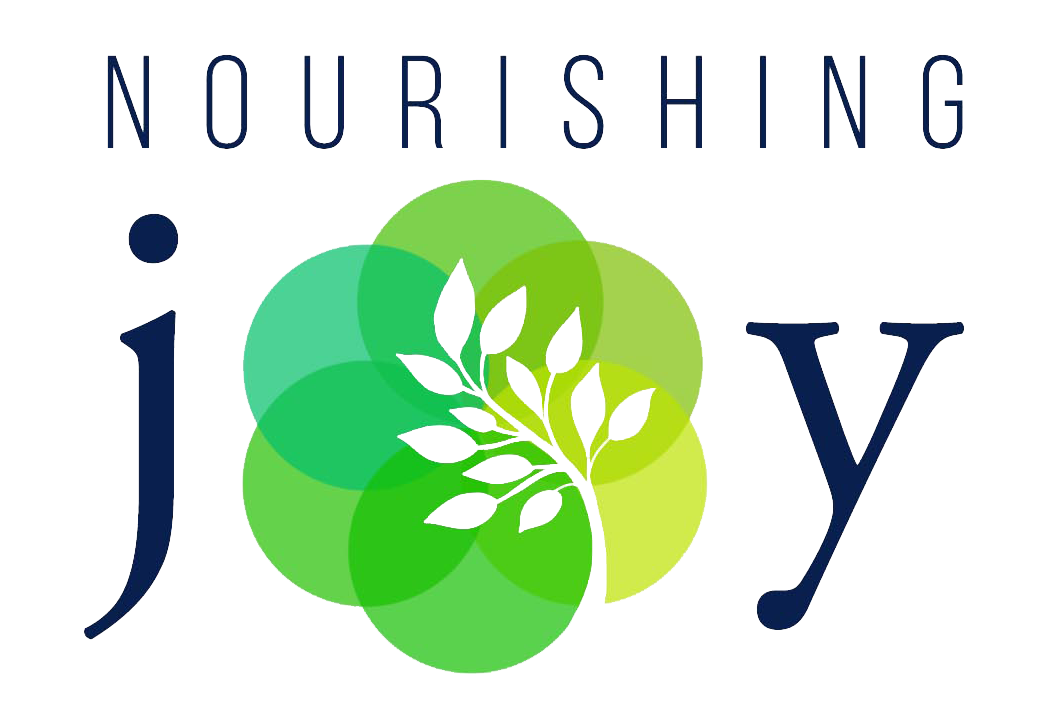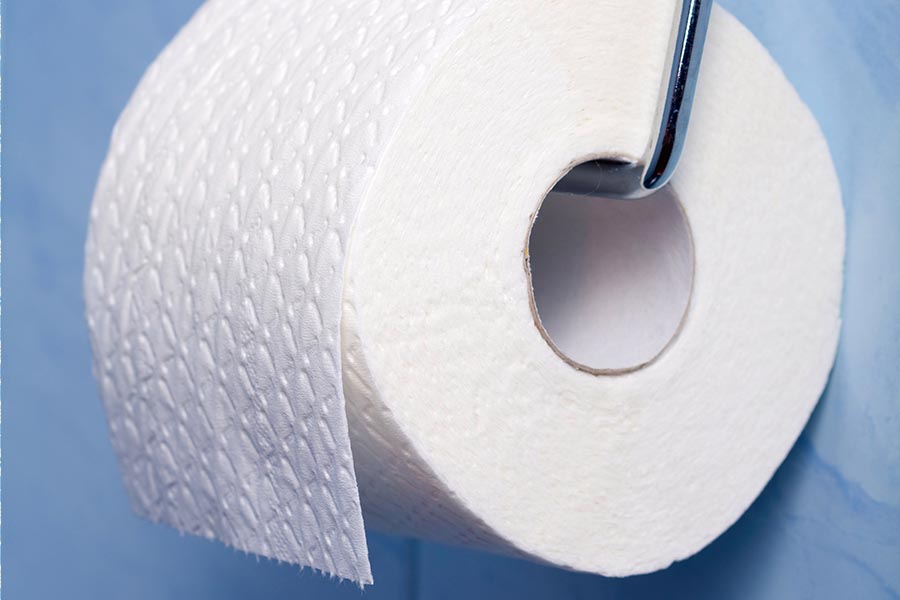How to Make Your Own Toilet Paper (and why you might never go back)
This post may contain affiliate links, including those from Amazon.com, which means we earn a small commission off your purchases. And here's the thing: We only mention services and products that we think are truly worth your attention, whether they're free, paid, or otherwise. This site relies on YOUR trust, so if we don't stand behind a product 110%, it's not mentioned. Period.

Our family has done a lot of crazy things on our natural living journey.
It all started with cloth diapering – that was our “gateway activity” to all things crunchy.
Then we started making our own yogurt and granola.
Soon I started making all our own soap, shampoo, and laundry detergent.
We began eating more organ meat and gelatin.
Then I got a little bit obsessed with making all our own condiments. (So obsessed, in fact, that later, Simon and Schuster invited me to write a book about DIY pantry staples. I ended up writing two books, the paperback The DIY Pantry and an ebook, Restocking the Pantry.)
We started fermenting everything, including fish sauce and an ever-present vat of kombucha on the counter, and everything we baked, we baked with sourdough.
…
But by far, the craziest thing we ever did (or so it seemed at the time) was switching to reusable toilet paper, aka cloth wipes, aka family cloth.
You have to admit, the “ick” factor is high when you think about it, but honestly, what's the difference from all our travels in Central America, South America, and Europe, where pit toilets and fancy hotels alike have plumbing that can't deal with the paper? In those places, it's always habit to throw the used toilet paper in a trash bin next to the toilet, so when we thought about it, using reusable cloth wipes at home was hardly any different.
Besides, cloth feels nice. 🙂
And honestly, after we had been doing it for a week or two, we barely even noticed the difference. It was simply habit. Using reusable toilet paper is SO easy that what seems gross at first simply goes away and it becomes your new normal. (I know it may not seem that way when you first think about it, but I promise, you'll wonder why you didn't begin ages ago.)
And the beautiful thing is that it's not an all-or-nothing proposition. I stock our bathroom with cloth wipes AND paper toilet paper, for a number of reasons:
- That way guests don't have to feel like we forgot to refill the toilet paper for them.
- That way you can use cloth when you want, paper when you want, and STILL use less toilet paper overall.
- You can use cloth for #1 and toilet paper for #2, if you want.
- Or for the potty-training toddler who wants to throw everything in the toilet, paper is available to be thrown in rather than cloth. (Yeah… cloth wipes will clog the plumbing reeeeeeeal quick.)
- Or for a reticent spouse, paper's still available as desired.
So, let's deal with the how and why and all the nitty-gritties:
So, why start with cloth wipes, aka DIY Toilet Paper?
If you're reading this, it's likely you already have a good reason. 🙂
Perhaps you recently learned that the equivalent of almost 270,000 trees is either flushed or dumped in landfills every day and roughly 10 percent of that total is attributable to toilet paper and you want to do something a little more sustainable.
(By the way, I adore the toilet paper from Grove, which is made entirely from sustainable bamboo and sugarcane and shipped completely plastic-free.)
Perhaps your toilet paper is just too rough on your skin (or your child's skin).
Or maybe you're tired of buying toilet paper so often (how does one family go through it so fast???) and you want to save some money.
Or, perhaps, you're in the midst of the COVID-19 pandemic and all the toilet paper has sold out all over your city and you need a different option. 🙂

Where do I find cloth wipes? Can I make them?
Cloth wipes can be pretty much anything and you can make them for pennies or buy luxurious pre-made ones that will last for years. Like anything, there are a ton of options.
To make them, simply find several large pieces of flannel or combed cotton cloth, like old baby blankets or worn-out sheets. (If you use cotton sheets, you want it the texture of flannel, no jersey or flat cotton.) Cut them into 8×8″ squares. If you have a sewing machine (or even better, a serger), do a quick zig-zag pattern along the edges to keep them from fraying. That's it!
If you want to purchase them, my favorites by far are simple ones. These are the ones I stocked up on years ago (and continue to love, nearly a decade later). Personally, I recommend single ply because they're sturdy yet flexible enough to get into all the crevices, but some people prefer double ply. Totally up to you.
Another premade option is to buy cheap-o baby washcloths at the dollar store. For me, the edges curl up too much after multiple washings, but that's truly just personal preference.
And keep in mind, for a family, you'll likely need 45-50 wipes to keep a good rotation going.
How do I store them?
You can fold them nicely in half and set them on the back of the toilet or in a decorative box nearby.
Or, if you don't have patience to fold them (ahem…), you can repurpose an old tissue paper box and stuff them in to pull out as needed.
Or just toss them in a pretty basket and have them close at hand.
Totally up to you.
What do you do with them after they're used???? I mean… eww…. gross!
You simply need a container to discreetly collect the used wipes. Nothing big or special.
I wanted something elegant, so I went to the thrift store and found a tall, slightly urn-shaped vase that fit nicely beside our toilet and that didn't overtly announce its presence. I like having an open top so that there's nothing to fiddle with to get the wipe in and having an urn shape still kept that open top a bit discreet.
Other people may prefer a mini trash can with a flip lid for discretion, like this one.
Another option is to hang a waterproof, zippered bag near the toilet for used wipes. These bags are easily procured – they're the same kind you'd use to keep wet swimming suits in after a visit to the pool. They're also readily available on any cloth diapering website.
The upside to wet bags is they tend to come in beautiful fabrics, so they actually beautify the bathroom AND you never need to touch the wipes when they get to the wash – just unzip, invert, and toss into the wash, bag and all. Here's one midsize option in floral or elegant grey.
Here are a few things you may want to keep in mind when choosing a dirty wipe receptacle:
You want it small enough that you can carry it directly to the washing machine and toss everything in there. No need to handle it more than necessary.
You may line it with a washable liner, if desired. You can use a cloth diapering wet bag or I repurposed a linen liner from a pretty wicker basket. Creativity is your only limitation here.
Doesn't it smell up your bathroom???
Only if someone has been sick and needed to use A LOT of wipes. In that case, simply wash sooner than usual. (Which would be a good idea anyway if someone's been sick.)
To minimize aroma, choose a container with a lid or a zipper.
Also – and heads-up, for the uninitiated, this may sound double-gross, but hang with me – you can also keep a box of latex gloves nearby and teach your family that if they've got lots of …. um, material… on their wipe, they can don a glove and swish the wipe in the toilet before flushing. It's definitely another layer of ick, but it reduces the possible aroma to next to nil.
Either that, or teach them to use paper for the first wipe and finish with cloth. 🙂
What about washing???
Washing couldn't be easier.
When we started with cloth wipes, we were in the midst of cloth diapering two babes – a toddler and an infant – so it was super-easy to simply throw the used wipes in with the diaper load in the laundry. Easy peasy.
And once we were done diapering, it wasn't much more difficult. At that point, I simply started tossing them in with the bath towels, which I tend to wash on hot with an extended wash anyway to kill all the nasty bacteria that gets wiped off various body parts after a bath or shower and tends to grows in hot, humid bathrooms.
(Just make sure there are no kitchen linens in with your towels.)
Keep in mind that if the wipes have been used for #2, you will need to wash your wipes about every three days. If they're just used for pee, you can stretch that a bit. Either way, you'll need to do a hot wash.
I like scented toilet paper. Can I scent cloth wipes?
Yes, absolutely, but there is one important caveat:
To scent cloth wipes, choose your favorite essential oil. HOWEVER (and this is important), you can't just drip it on the wipes themselves – otherwise, you'll end up wiping those same essential oils directly onto your skin (and on particularly sensitive areas, at that), which makes for a dangerous and potentially painful situation.
Instead, store your cloth wipes in a decorative box with a lid and drip 6-8 drops of your favorite essential oil blend onto a cotton ball or a sacrificial wipe that won't be used. Place the cotton ball in the box with the wipes and the scent will infuse into the wipes. You'll also get the scent each time you open the box. 🙂
(By the way, we love essential oils here at Nourishing Joy! We don't promote any specific brands, but we're passionate about using them safely and we hope we're infectious in our excitement about them. 🙂 If you want to learn how to use essential oils safely, we invite you to take our free, 10-day essential oil class or snag our Essential Oil Binder to have COPIOUS amounts of information about essential oils always close at hand.)
So, that's DIY toilet paper / reusable toilet paper / reusable cloth wipes / family cloth in a nutshell. 🙂
Be safe and healthy!




